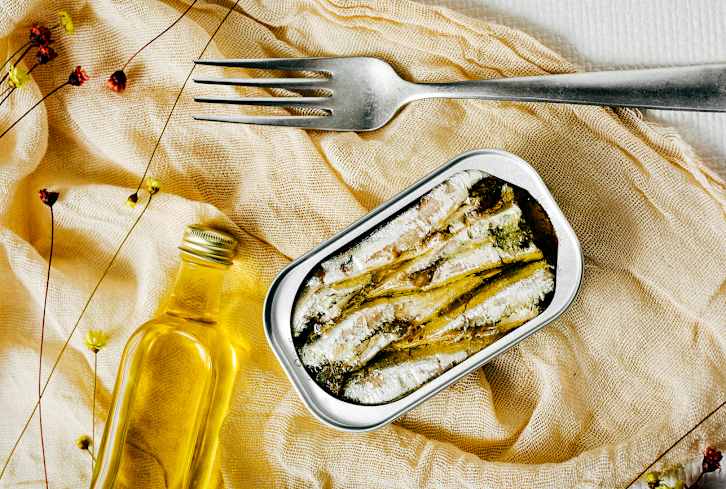Advertisement
All The Different Reasons EPA & DHA Are So Important For Your Health


Though they're far from the only omega-3s out there, they are the most researched, so EPA and DHA certainly dominate the conversation around these healthy fats. So it's not like they're hogging the spotlight undeservedly; a wealth of scientific research backs the benefits of these two omega-3s, showing their importance throughout our entire lifespan, from before we leave the womb until our later years.
While many of us tend to lump EPA and DHA together when we think about omega-3s, consuming healthy fats in our diet, quality fish oil supplements, and the like, they are (of course!) two different fats—and each has unique chemical structure, properties, and functions in the body worth calling out.
Here's a breakdown of what we know about these two must-have fats, how each supports your health, and how to make sure you're getting your fill.
Where do EPA and DHA come from?
Short for "eicosapentaenoic acid" and "docosahexaenoic acid," EPA and DHA are healthy polyunsaturated fatty acids often touted for whole-body antioxidant actions, supporting a normal inflammatory response1, promoting cardiovascular health and cognition, supporting a positive mood2, keeping vision sharp3, and more.*
Though we can technically produce EPA and DHA from another omega-3, called ALA, we can only synthesize small (and highly variable) amounts4, which means it's important that we get EPA and DHA from our daily nutrition. (We don't currently have official daily recommended intakes5 for EPA and DHA, but that's something many researchers and health professionals are trying to change.)
Generally, seafood (particularly fatty fish, like anchovies, salmon, mackerel, tuna, etc.), as well as the algae that provide seafood with its omega-3 content, are considered the best food sources of EPA and DHA. So, if you've ever been told to eat fish twice a week, that's why.
But as mbg's director of scientific affairs Ashley Jordan Ferira, Ph.D., RDN, points out, "This two-fish-a-week recommendation has existed for at least 20 years, yet we're falling way short. The nutritional gap of EPA and DHA in our diet is massive (90% plus of Americans6 are not meeting this minimum recommendation). The scientific case for a reliable and meaningful daily source of these marine omega-3s is robust."
And even though we're about to break down some of the unique roles EPA and DHA play in the body for you, there's an important caveat to mention. Ferira and other scientists believe it's still important to consider the EPA-plus-DHA duo together when it comes to addressing this nutritional gap and supporting a variety of health outcomes holistically.*
"I don't like to say EPA is for the heart and DHA is for the brain. EPA and DHA are pleiotropic, multitasking, awesome fats, and they're both important to have together,"* Ferira recently shared with mbg's co-founder and co-CEO Jason Wachob on the mindbodygreen podcast.
A deeper dive into EPA.
EPA, or eicosapentaenoic acid, is considered a long-chain polyunsaturated fat. (It gets this "long-chain" title because an EPA fatty acid includes a chain of 20 carbons.) The body converts some EPA into DHA, but EPA has plenty of its own functions and purposes.
Research suggests that, of these two high-profile omega-3s, EPA is the one that seems to be more influential for behavior and mood7. In fact, studies show that, compared to DHA, EPA better supports a positive, balanced mood 8based on participants' ratings of their well-being.*
What's more, EPA plays a unique role (from DHA) in our body's inflammatory pathways, directly supporting immune function by helping to promote balance between pro- and anti-inflammatory compounds (aka proteins known as cytokines that are essential for our body's immune response).*
A closer look at DHA.
Like EPA, docosahexaenoic acid is also a long-chain polyunsaturated fatty acid, but it's got two more carbons than EPA in the chain that makes up its structural backbone (that's 22 carbons, in case you're counting).
DHA is often talked about for the important roles it plays in brain development7, both while we're still in the womb and after.* Not only does DHA make up a lot of the gray matter in our brains, but it's also a key component of cell membranes (which have a major impact on normal cellular functions and signaling), as well as neurons (the cells throughout the brain and entire central nervous system that send and receive messages).* DHA is also crucial for eye development9 and functioning throughout life and found in large quantities in our retinas.*
In terms of cardiovascular health10, DHA gets a special shout-out as it has a notable relationship with lipids (triglycerides and cholesterol compounds), blood pressure, and platelet aggregation, studies indicate.*
When it comes to anti-inflammatory actions and critical roles in immune function, research demonstrates that DHA plays a major and synergistic role with EPA, decreasing genetic expression of four types of pro-inflammatory proteins and affecting white blood cell (our immune system's "boots on the ground") production of key cytokines, and more.*
As Ferira explains, "When it comes to normal and active resolution of inflammatory pathways and supporting immune response pathways in the body, DHA and EPA are both critical precursors for unique families of lipid bioactives in the body known as "proresolving mediators."11 This critical network of lipid compounds was only discovered in the past 30 or so years, thanks to Charles Serhan, Ph.D., at Harvard and others."*
In fact, there's an entire field dedicated to this research known as "resolution physiology." Ferira goes on to say that, "the bottom line is that without EPA and DHA being provided to our body via diet and/or supplementation on a regular basis, these lipid bioactives are simply not being produced (and are thus, literally not available to do their critical work in these inflammatory and immune-relevant pathways), which is mind-blowing and straight-up concerning."*
Getting the EPA & DHA you need.
Given the diverse and vital roles EPA and DHA have in our development and long-term health, it's no wonder that so many health experts and researchers would like to see more specific guidelines and public health messaging around our nation consuming more of these incredibly important fats.
For now, the American Heart Association12 (AHA) and the Dietary Guidelines for Americans recommend eating 8 ounces of fish per week (that's approximately two servings), which equates to about 250 to 500 milligrams of EPA and DHA per day. That's your starting point. As it stands, Americans are only consuming 86 milligrams of this omega-3 pairing daily13.
That gap widens when we consider the fact that the AHA, researchers, and many health care practitioners recommend more than 1,000 milligrams per day of EPA and DHA for optimal heart health and whole-body health support.* For context, that would be like eating the EPA and DHA nutritional equivalent of a serving of oily, omega-3 rich every day.
Consider working with a nutritionist or another health care practitioner to ensure you're optimizing your EPA and DHA intake and supplement regimen for your individual needs.*
And, unless you're taking that weekly trip to the fish counter (or at least regularly topping your salads with tinned fish, like sardines), you might also want to consider a high-quality fish oil supplement that provides meaningful and balanced amounts of EPA and DHA, such as mbg's omega-3 potency+.*
13 Sources
- https://www.ncbi.nlm.nih.gov/pmc/articles/PMC3257651/
- https://pubmed.ncbi.nlm.nih.gov/21784145/
- https://www.ncbi.nlm.nih.gov/pmc/articles/PMC7230711/
- https://academic.oup.com/ajcn/article/83/6/1467S/4633217
- https://pubmed.ncbi.nlm.nih.gov/19525100/
- https://pubmed.ncbi.nlm.nih.gov/28956299/
- https://pubmed.ncbi.nlm.nih.gov/18072818/
- https://pubmed.ncbi.nlm.nih.gov/22910528/
- https://www.karger.com/Article/Pdf/448262
- https://pubmed.ncbi.nlm.nih.gov/21349231/
- https://www.ncbi.nlm.nih.gov/labs/pmc/articles/PMC7682745/
- https://www.heart.org/en/healthy-living/healthy-eating/eat-smart/fats/fish-and-omega-3-fatty-acids
- https://www.ncbi.nlm.nih.gov/pmc/articles/PMC3992162/


















